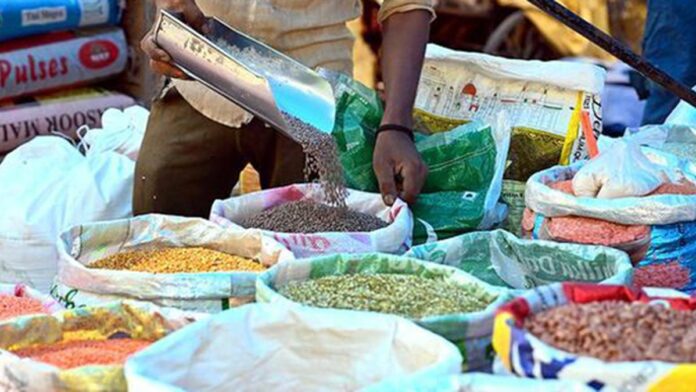
Photo used for representation purpose only.
| Photo Credit: Sushil Kumar Verma
The story so far:
It has been what one may call, a bittersweet year for the economy, with a sweet first half, when growth surprised everyone, including the government. And a difficult latter half by the end of which the Reserve Bank of India (RBI) and Finance Ministry mandarins are sparring, as diplomatically as possible, over who is to be blamed for sputtering growth, a persistently resurgent inflation trajectory and the flux this creates for policy making.
Why is there a clamour for a rate cut?
Top government functionaries have been making noises since late November about the need for RBI to cut rates, with some suggesting it should ignore volatile food prices and prioritise growth and investments. The reason for their seemingly urgent pitches became clearer when the Q2 GDP numbers revealed a 7-quarter low growth of 5.4%, with urban demand tottering and showing up in underwhelming corporate results that also affected market sentiment.
How were things this time last year?
India’s stock markets were at record highs, the Gross Domestic Product was reported to have risen 7.7% in the first half of 2023-24, from 7.2% a year earlier. The Finance Ministry expected growth to be “over 6.5%” for the full year, as it geared up for an interim Budget ahead of the Lok Sabha polls. The RBI was expected to start an interest rate cut cycle in the second half of 2024 as it had projected inflation to average 4% — its median target — through July-September.
But didn’t the economy do far better in 2023-24?
Yes, the National Statistical Office (NSO) growth estimates for 2023-24 turned out to be way healthier than all projections, partly because of revisions in earlier quarters’ numbers. The first half of 2023-24 was reckoned to have grown around 8.1%, followed by an 8.6% spike between October and December 2023 (third quarter, or Q3), a 7.8% growth in the first three months of 2024. 2023-24 had ended up with a remarkable 8.2% uptick. The first quarter of 2024-25 was largely taken up by the election process. The BJP suffered some reverses, but attained 240 seats in the Lok Sabha and the NDA returned to office with a little help from some allies, and a semblance of continuity was maintained in the cabinet, especially for key economic portfolios like Finance and Commerce.
What did the post-poll Budget offer?
In the full Union Budget for 2024-25 presented in July, Finance Minister Nirmala Sitharaman ramped up references to employment and the middle class and unveiled schemes to spur skilling and job creation with some token tax cuts for income tax payers, that were hoped to alleviate the effects of inflation and boost consumption. While a sustained consumption pick-up was necessary to stimulate greenfield and brownfield private investments, Ms. Sitharaman acknowledged that public spending on infrastructure had to lead the way yet again this year and announced a ₹11.11 lakh capex plan. The government exuded confidence that India would record its fourth successive year with 7% or higher growth, since COVID-19 had tripped the economy.
How did things pan out?
The first growth data for 2024-25, released after the Budget, showed GDP had risen at a five-quarter low of 6.7%. However, this didn’t ring any alarm bells at the time — the prolonged polling process had affected capital spending plans by the Centre and the States which effectively scuppered a major growth lever. The mood was still upbeat but some had begun to worry. “Growth moderated in the April-June quarter as high interest rates temper urban demand,” said Louis Kuijs, Asia-Pacific chief economist at S&P Global Ratings in September. The firm expected India to grow 6.8% this year at the time, well below the 7.2% projected by the RBI. After the Q2 growth shock, many have pared their 2024-25 growth projections down, including the Finance Ministry which now expects it to be around 6.5%, while some worry India has entered the throes of a prolonged cyclical slowdown.
Meanwhile, though consumer price inflation remained under 6% through most of the year, it didn’t get near the RBI’s goal till July when it hit a five-year low of 3.5%, followed by another benign print in August. Yet, rate cut hopes in the October monetary policy review were scotched by food prices that shot up, starting in September, lifting the headline inflation closer to 6% again. With food prices still a worry and edible oils spurting up, the RBI did not budge on interest rates this month as well, even as it noted the growth-inflation situation is no longer well-poised, slashing its 2024-25 growth projection to 6.6% from earlier hopes of 7.2%.
With slowing growth and high inflation, what next?
While high interest rates hurt demand and lower rates will help private consumption and, in turn, investments too, inflation hurts consumption spending as well. The government has appointed a new Governor at the RBI, but a change of guard may not suffice for a rate cut in February as inflation needs to ebb quickly too. That North Block and Mint Street are not seeing eye to eye on who needs to blink first to break this growth-inflation flux was apparent as the year drew to a close. An RBI article made a solid case for ‘excoriating inflation now’ to get consumption, growth and investment going on a strong footing. The latest economic review by the Finance Ministry, in turn, sought to blame the “monetary policy stance” for some of the recent demand slowdown. The growth and inflation rebalancing act, therefore, will be the one to watch out for in 2025, apart from any surprises the next U.S. President throws up.
Published – December 29, 2024 02:37 am IST
#inflation #matter #Explained
